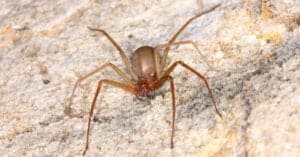All spiders are strange, and this one is no different from the other, except it’s blue. In the natural world, very few creatures are blue. Blue is uncommon in most natural things because it is not the result of pigment. Instead, this lovely color comes from the naturally occurring photonic nanostructures. When a blue creature is discovered, it’s a big deal for researchers. Whether or not you are a fan of arachnids, this is one cool blue tarantula!
A Discovery in Thailand
One day in the Phang-Nga province of Thailand, a tarantula was discovered that was once called the Chilobrachys sp. Electric Blue Tarantula or the bamboo culm tarantula by the commercial market. This was the first time this tarantula was found in the wild. Sadly, over 1,200 tarantulas are in the commercial online market, with some of those species being close to extinction. The spider was renamed and filed as a new species, Chilobrachys natanicharum.
The discovery in 2022 of this tarantula was the first finding of a tarantula living in bamboo. Typically, tarantulas live deep in their burrows on the forest floor. However, with the high tide in that area, it is safest for the animal to seek refuge higher up so as not to drown. Deep within the Thai mangrove forest, the Chilobrachys natanicharum lives high up in their very own beautiful bamboo spidey castle. Such news would make Spiderman proud!
Dr. Narin Chomphuphuang, researcher at Khon Kaen University became compelled to visit the mangrove forest in the Thai jungle again to see the Taksinus bambus for himself. “The first specimen we found was on a tree in the mangrove forest. These tarantulas inhabit hollow trees, and the difficulty of catching an electric-blue tarantula lies in the need to climb a tree and lure it out of a complex of hollows amid humid and slippery conditions. During our expedition, we walked in the evening and at night during low tide, managing to collect only two of them,” Narin said.
Chilobrachys natanicharum
The beautiful Chilobrachys natanicharum lives at varying elevations. The tarantula has bluish-purple hair on its legs and body. Immature males and females tend to have more violet in their hair than metallic blue. On mature males, the color is vibrant, like with many species. The female’s coloring is a bit quieter.
The male spider measures up to two inches, while the larger female measures up to two and a half inches long. On older Chilobrachys natanicharum tarantulas, the hair on their bodies becomes brown, and only their legs retain the electric bluish-purple hair. This blue coloring is why they became highly sought after in the pet trade and are almost extinct in the wild.
Positive Affect of the Community
These beautiful electric blue to violet-blue spiders, with iridescent effects, are in serious danger. The destruction of its habitats and poaching for the commercial market has left few in the wild. Conservation projects are underway, and breeders are urged to join and help sustain the species and other similar species in the Thailand jungles and mangrove forests.
The magnificent tarantula’s new scientific name was courtesy of Mr. Natakorn Changrew and Ms. Nichada Changrew, who own Nichada Properties Co. Ltd., a Thai real estate company. An auction unfolded for the naming of the spider, with Nichada Properties Co. Ltd. as the winner. The money from the auction bidding went to aid cancer patients and the impoverished Lahu children in Thailand. The Lahu people of approximately 3,300 make up an indigenous tribe in northern Thailand, known for their tradition-rich culture and life.
Thank you for reading! Have some feedback for us? Contact the AZ Animals editorial team.








